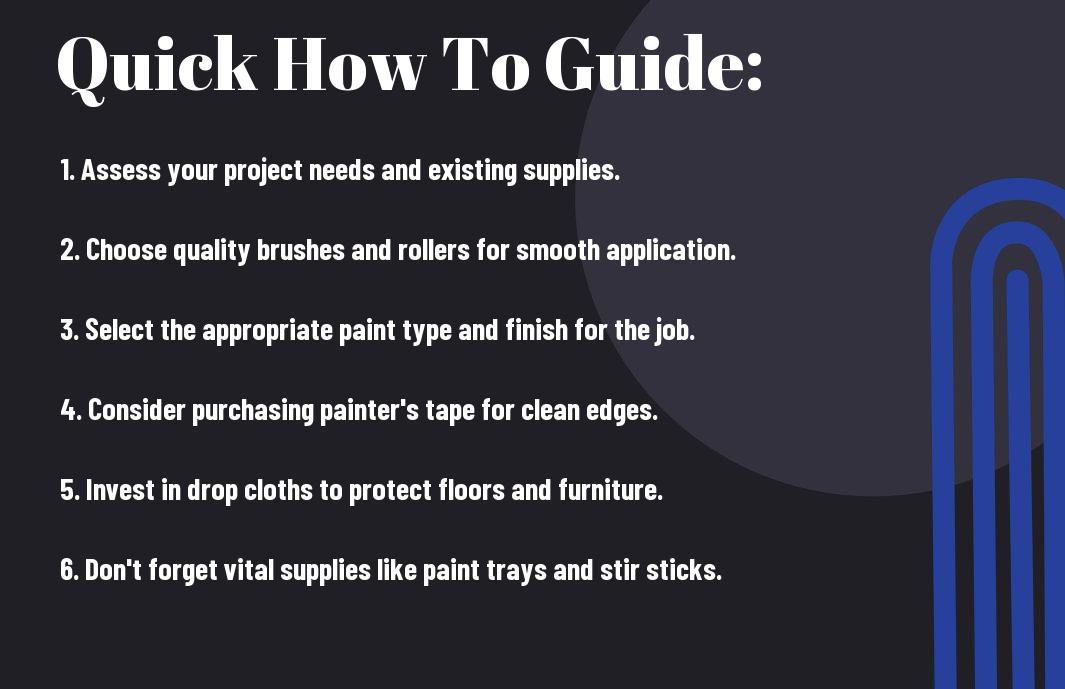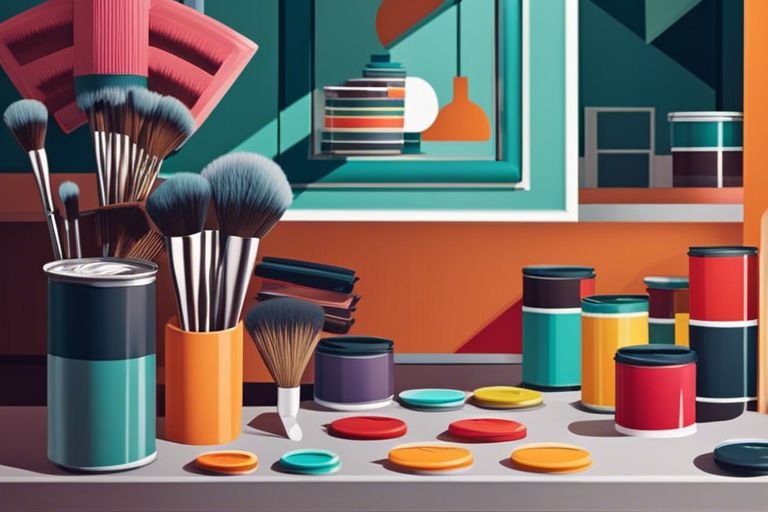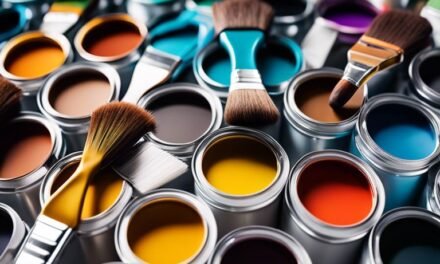Many DIY projects involve painting, and selecting the right painting supplies can make a significant difference in the outcome. Ensuring you have high-quality brushes, durable drop cloths, and long-lasting paint is vital for a successful project. This guide will help you navigate through the options available and pick the best supplies for your home painting undertaking.
Key Takeaways:
- Quality over Price: Invest in high-quality paints and brushes to ensure a professional finish and long-lasting results.
- Consider Your Project Needs: Choose the right type of paint (water-based, oil-based, etc.) and brushes (natural bristles, synthetic, etc.) based on the surface you are painting and the desired outcome.
- Proper Preparation is Key: Sanding, priming, and using the right tools can make a significant difference in the final result of your DIY painting project.

Understanding Your Painting Project Needs
Determining the Scope of Your Project
While begining on a painting project, the first step is to understand the scope of work involved. Consider whether you are painting a single room, multiple rooms, the exterior of your home, or just a piece of furniture. This will help you determine the amount of paint and supplies you will need, as well as the time and effort required.
Identifying the Surfaces to be Painted
Understanding the surfaces you plan to paint is crucial in selecting the right products for your project needs. Identify whether you will be painting walls, ceilings, trim, doors, or different materials like wood, metal, or concrete. Each surface may require specific preparation steps and types of paint for optimal results.
For instance, painting a bathroom with high moisture levels may require special moisture-resistant paint while painting a metal railing might need a primer for better adhesion.
Considering the Desired Finish and Color
Your project’s outcome greatly depends on the finish and color you desire. Different paint finishes like matte, satin, or gloss can create various aesthetics and serve different purposes. Choosing the right color is important as it can dramatically impact the overall look and feel of your space.

Factors to Consider When Choosing Painting Supplies
Some important factors to consider when choosing painting supplies for your home DIY project are quality, brand reputation, customer reviews, environmental impact, safety concerns, and price. Each of these factors plays a crucial role in ensuring a successful and satisfying painting experience.
Quality vs. Price: Finding the Right Balance
The quality of your painting supplies will have a direct impact on the final result of your project. While it can be tempting to opt for the cheapest options available, quality should always be a top priority. Assume that higher-quality paints and brushes will result in a smoother finish, better coverage, and longer-lasting results. However, this doesn’t mean you have to break the bank – finding a balance between quality and price is key.
Brand Reputation and Customer Reviews
Balance the brand reputation and customer reviews of painting supplies to help guide your decision-making process. It’s important to choose brands that have a reputation for producing high-quality products and have received positive feedback from customers. It can be beneficial to do some research online and read reviews to get an idea of the experiences others have had with the products you are considering.
Environmental Impact and Safety Concerns
Painting supplies can have a significant environmental impact and raise safety concerns if not chosen carefully. Look for paints and brushes that are labeled as low-VOC (volatile organic compounds) and environmentally friendly. Price should not be the only determining factor when it comes to the impact these products can have on your health and the environment. Choose products that prioritize safety and sustainability to create a safe and eco-friendly painting environment.
How to Select the Right Paint
Choosing the Right Paint Type (Latex, Oil-Based, etc.)
After preparing your space for painting, the next step is choosing the right type of paint for your DIY project. You will typically come across two main types of paint: latex and oil-based. Latex paint, also known as acrylic paint, is a popular choice for interior walls due to its quick drying time, easy clean-up with water, and low odor. On the other hand, oil-based paint offers a durable finish and is ideal for high-moisture areas like kitchens and bathrooms.
Understanding Paint Finishes (Matte, Semi-Gloss, etc.)
For a successful painting project, it’s vital you understand different paint finishes. Matte finishes create a smooth, subtle look and are excellent for hiding imperfections on walls. Semi-gloss finishes, on the other hand, are durable and easy to clean, making them perfect for high-traffic areas like hallways and kids’ rooms.
Paint finishes not only impact the aesthetics of your space but also affect the durability and maintenance of the painted surface. Choosing the right finish can make a significant difference in the longevity and overall look of your project.
Selecting the Perfect Color for Your Project
Paint color plays a crucial role in setting the tone and ambiance of a room. The color you choose should complement the existing decor and match your personal style. Consider factors like natural light, room size, and the mood you want to create. Lighter colors can make a room feel more spacious, while darker tones add warmth and coziness.
Your choice of color is a reflection of your personality and can transform a mundane space into a vibrant, inviting area. Take your time selecting the perfect shade that resonates with you and enhances the overall aesthetic of your home.
Tips for Choosing the Best Brushes and Rollers
All set to start your home DIY painting project? You need to ensure you have the right tools for the job to achieve a professional finish. Here are some tips for choosing the best brushes and rollers for your painting project:
Natural vs. Synthetic Bristles: Which is Best?
Choosing between natural and synthetic bristles can be a crucial decision when selecting a paintbrush. Natural bristles are ideal for oil-based paints, varnishes, and stains because they can hold more paint and provide a smoother finish. On the other hand, synthetic bristles are better for water-based paints as they are durable and maintain their shape better. The type of paint you are using will determine whether natural or synthetic bristles are best for your project.
Brush Size and Shape: How to Choose the Right One
Shape and size matter when it comes to selecting a paintbrush for your project. A larger brush is suitable for painting large surfaces, while a smaller brush is ideal for detailed work. The shape of the brush also affects the outcome of your painting project. For example, angled brushes are great for cutting in edges and corners, while flat brushes are perfect for larger, flat surfaces.
Understanding the different brush sizes and shapes will help you choose the right one for each part of your project, ensuring a professional finish.
Roller Covers: Understanding Nap Length and Material
While selecting a roller cover for your painting project, consider the nap length and material of the cover. The nap length refers to the thickness of the roller cover, with longer naps holding more paint and providing a textured finish. Additionally, the material of the roller cover, whether foam, polyester, or lamb’s wool, can affect the smoothness and coverage of the paint.
Which roller cover you choose depends on the type of surface you are painting and the desired finish. Consider the nap length and material carefully to achieve the best results for your project.
The Importance of Primer and How to Choose the Right One
When to Use Primer and Why
Despite primer not always being considered a necessary step in a painting project, using it can make a significant difference in the final outcome. An important rule of thumb is to use primer whenever you are painting over a different type of surface, such as bare wood or metal, or when covering stains or discoloration. Primer creates a uniform surface for the paint to adhere to, improving its durability and longevity.
Types of Primer: Stain-Blocking, Bonding, and Filler
An crucial aspect of achieving a professional finish is selecting the right type of primer for your specific project. Primer comes in various formulations tailored to different needs, such as stain-blocking, bonding, and filler primers. Stain-blocking primers are crucial for concealing water stains, smoke damage, and other types of discoloration, while bonding primers are ideal for improving paint adhesion on challenging surfaces like tiles or laminates.
This table outlines the differences between stain-blocking, bonding, and filler primers:
| Type of Primer | Primary Use |
| Stain-Blocking Primer | Conceals stains and discoloration |
| Bonding Primer | Improves adhesion on challenging surfaces |
| Filler Primer | Smoothens surfaces and fills imperfections |
How to Select the Right Primer for Your Project
Choose the best primer based on the specific needs of your project. If you are dealing with stubborn stains or odors, a stain-blocking primer is your best bet. For surfaces that require better adhesion, opt for a bonding primer to ensure long-lasting results. Additionally, if you are working with rough or uneven surfaces that need smoothening, a filler primer will be most effective.
Additional Painting Supplies You May Need
Painting Tools: Trays, Liners, and More
Now, let’s talk about some additional painting supplies you may need for your home DIY project. Trays, liners, and other painting tools are crucial for efficiently getting the paint onto your walls. A paint tray makes it easy to load up your roller without dipping it into the paint can each time. Liners can also be useful as they make cleanup a breeze.
Drop Cloths and Tarps: Protecting Your Floors and Furniture
Trays are not the only supplies you’ll need – it’s also crucial to protect your floors and furniture during the painting process. This is where drop cloths and tarps come in. By laying down protective coverings, you can prevent accidental drips or spills from damaging your surfaces. These are especially important for larger projects or if you’re painting indoors.
This extra step may seem tedious, but it can save you a lot of time and effort in the long run. Protecting your floors and furniture will not only make cleanup easier but also ensure that your home remains in top condition throughout the painting process.
Sandpaper and Other Surface Preparation Tools
Tools like sandpaper and other surface preparation tools are crucial for achieving a smooth and professional-looking finish. To ensure that your paint adheres properly and that the surface is free of imperfections, sandpaper is a must-have. It helps in smoothing out rough patches, removing old paint, and creating a clean surface for your new paint to adhere to.
To wrap up
Following this guide on how to choose the best painting supplies for your home DIY project, you can ensure a smooth and successful painting experience. By selecting high-quality brushes, rollers, paints, and other crucial tools, you can achieve professional results and avoid common pitfalls. Remember to consider the type of surface you are painting, the desired finish, and the level of detail required when selecting your supplies. If you need further recommendations, you can refer to 12 Painting Tools You Need (And Ones You Don’t).





